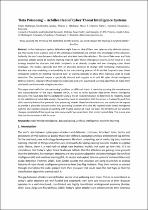JavaScript is disabled for your browser. Some features of this site may not work without it.
- ResearchSpace
- →
- Research Publications/Outputs
- →
- Conference Publications
- →
- View Item
| dc.contributor.author |
Mahlangu, Thabo V

|
|
| dc.contributor.author |
January, Sinethemba

|
|
| dc.contributor.author |
Mashiane, Charmaine T

|
|
| dc.contributor.author |
Dlamini, Thandokuhle M

|
|
| dc.contributor.author |
Ngobeni, Sipho J

|
|
| dc.contributor.author |
Ruxwana, Lennox N

|
|
| dc.date.accessioned | 2019-03-26T06:40:07Z | |
| dc.date.available | 2019-03-26T06:40:07Z | |
| dc.date.issued | 2019-02 | |
| dc.identifier.citation | Mahlangu, T.V. et al. 2019. ‘Data Poisoning’ – Achilles heel of cyber threat intelligence systems. Proceedings of the 14th International Conference on Cyber Warfare and Security (ICCWS 2019), Stellenbosch University, South Africa, 28 February - 1 March 2019 | en_US |
| dc.identifier.uri | https://bit.ly/2FpH9cf | |
| dc.identifier.uri | http://hdl.handle.net/10204/10853 | |
| dc.description | This is the accepted version of the published paper. | en_US |
| dc.description.abstract | In the cyberspace, system defenders might have an idea of their own cybersecurity defense systems, but they surely have a partial view of the cyberspace battlefield and almost zero knowledge of the attackers. Evidently, the arm's race between defenders and attackers favors the attackers. The rise of fake news and `data poisoning' attacks aimed at machine learning inspired cyber threat intelligence systems is the result of a new strategy adopted by attackers that adds complexity to an already complex and ever changing cyber threat landscape. The modus operandi and TTPs of attackers continue to change with increasing repercussions. Attackers are now exploiting a vulnerability in the data training process of AI and ML inspired cyber threat intelligence systems by injecting `poisoned data' in training datasets to allow their malicious code to evade detection. The 'poisoned' corpus is specifically tailored and targeted to AI and ML cyber threat intelligence defense systems, especially those based on supervised and semi-supervised learning algorithms to make them misclassify malicious code as legitimate data. | en_US |
| dc.language.iso | en | en_US |
| dc.relation.ispartofseries | Worklist;22278 | |
| dc.subject | Cyberspace | en_US |
| dc.subject | Data poisoning | en_US |
| dc.subject | Cyber threats | en_US |
| dc.subject | Cyber threat intelligence | en_US |
| dc.subject | Artificial intelligence | en_US |
| dc.subject | Machine learning | en_US |
| dc.title | ‘Data Poisoning’ – Achilles heel of cyber threat intelligence systems | en_US |
| dc.type | Conference Presentation | en_US |
| dc.identifier.apacitation | Mahlangu, T. V., January, S., Mashiane, C. T., Dlamini, T. M., Ngobeni, S. J., & Ruxwana, L. N. (2019). ‘Data Poisoning’ – Achilles heel of cyber threat intelligence systems. http://hdl.handle.net/10204/10853 | en_ZA |
| dc.identifier.chicagocitation | Mahlangu, Thabo V, Sinethemba January, Charmaine T Mashiane, Thandokuhle M Dlamini, Sipho J Ngobeni, and Lennox N Ruxwana. "‘Data Poisoning’ – Achilles heel of cyber threat intelligence systems." (2019): http://hdl.handle.net/10204/10853 | en_ZA |
| dc.identifier.vancouvercitation | Mahlangu TV, January S, Mashiane CT, Dlamini TM, Ngobeni SJ, Ruxwana LN, ‘Data Poisoning’ – Achilles heel of cyber threat intelligence systems; 2019. http://hdl.handle.net/10204/10853 . | en_ZA |
| dc.identifier.ris | TY - Conference Presentation AU - Mahlangu, Thabo V AU - January, Sinethemba AU - Mashiane, Charmaine T AU - Dlamini, Thandokuhle M AU - Ngobeni, Sipho J AU - Ruxwana, Lennox N AB - In the cyberspace, system defenders might have an idea of their own cybersecurity defense systems, but they surely have a partial view of the cyberspace battlefield and almost zero knowledge of the attackers. Evidently, the arm's race between defenders and attackers favors the attackers. The rise of fake news and `data poisoning' attacks aimed at machine learning inspired cyber threat intelligence systems is the result of a new strategy adopted by attackers that adds complexity to an already complex and ever changing cyber threat landscape. The modus operandi and TTPs of attackers continue to change with increasing repercussions. Attackers are now exploiting a vulnerability in the data training process of AI and ML inspired cyber threat intelligence systems by injecting `poisoned data' in training datasets to allow their malicious code to evade detection. The 'poisoned' corpus is specifically tailored and targeted to AI and ML cyber threat intelligence defense systems, especially those based on supervised and semi-supervised learning algorithms to make them misclassify malicious code as legitimate data. DA - 2019-02 DB - ResearchSpace DP - CSIR KW - Cyberspace KW - Data poisoning KW - Cyber threats KW - Cyber threat intelligence KW - Artificial intelligence KW - Machine learning LK - https://researchspace.csir.co.za PY - 2019 T1 - ‘Data Poisoning’ – Achilles heel of cyber threat intelligence systems TI - ‘Data Poisoning’ – Achilles heel of cyber threat intelligence systems UR - http://hdl.handle.net/10204/10853 ER - | en_ZA |






